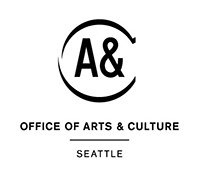Edwin Fountain, the Wood Sculptor of Mount Baker, Carves New Life Into Fallen Branches and Tree Stumps
You'll find his prolific carvings all around the shores of south Lake Washington.
On any random day at Colman Park beach or maybe somewhere along the shores of Lake Washington, you might find Edwin Fountain patiently carving life into a weathered stump or forgotten tree branch. The Alabama-born artist, now a well-known and loved fixture in Seattle's parks, approaches woodcarving with the quiet intensity of someone who understands that wood speaks its own language. Talking about a fallen madrona limb, he describes his process. "I've been looking at it, rubbing on it," he says about his process. "And you ready?" he asks the wood. "She's ready." For Fountain, this isn't just art, it's a conversation with the material itself, one that began decades ago in the rural landscapes of his youth.
Fountain's artistic journey started in Burnt Corn, Alabama, where his grandfather served as both mentor and moral compass, teaching practical skills with philosophical depth. "My grandfather told me something that was very important," Fountain recalls. "You don't want to make a living at art, you've got skills to make a living. Use your skills. Do your art for love."
These lessons took physical form when his grandfather would hand him tools with challenging instructions: "He'd hand me a toolbox, point to the tractor, and say, 'Take it apart.' Next day, same thing: 'Now put it back together.'" This training in patience and problem-solving became the foundation for his artistic practice.
After leaving Alabama at 18, Fountain's hunger for artistic growth took him to Los Angeles, where he studied figure drawing and ceramics. But it was the wood he found that truly spoke to him. "Found wood is seasoned and it's dried to its natural crack," he explains. "Pressed wood, when you buy it, and you take it and you mill it, it doesn't crack the same." His preference for materials that have lived a life reflects his own philosophy, that true beauty emerges from experience and resilience.
Fountain's toolbox is specific — Milwaukee power tools are preferred: "They have four different sizes of chainsaws that are good for sculpture." Dremels, axes, and grinders all work in harmony, allowing the wood itself to guide him. His favorite medium, madrona, reveals its secrets slowly: "Madrona is the hardest wood I've found so far … if you find one that's older, you might get the gold. And when I say gold, I mean anything you carve in it is gold. No paint, just clear stain, and it turns gold."
Since moving to Seattle to raise a family, Fountain has become something of a local legend, with his sculptures dotting parks from Mount Baker to areas further south, including a few located in Seward Park. The interactions with community members, especially children, fuel his creative spirit. "Having a 5-year-old explain a piece of art to you is the most insane thing you want to experience. Now, that's appreciation," he says, recalling one boy who "stood there at least 10 minutes" describing a sculpture to his initially hesitant father. "A 5-year-old … they're paying more attention to everything going on around you than you are."
Despite limited recognition from traditional art institutions, Fountain stays true to his path. "I never tried to get it recognized," he says with quiet determination. "It was a gift that I have and something that I enjoy." His artistic philosophy is refreshingly straightforward: "I try to create something that everybody's gonna like."
Although a tiny collection of his works was for sale at the Mount Baker Summer Festival in Hunter Boulevard park on June 21, he's not sure when they will be on display again. You can view his work at @eds_artrevised on Instagram.
For those lucky enough to encounter Fountain at work in Seattle's parks, he offers a simple invitation: "Enjoy it … if you see me out carving, say hello!" It's this openness, this willingness to share not just his art but his process, that makes Edwin Fountain's work truly special.
The Emerald's arts coverage is supported in part with funding from 4 Culture and the City of Seattle's Office of Arts & Culture. The Emerald maintains editorial control over its coverage.
Help keep BIPOC-led, community-powered journalism free — become a Rainmaker today.

